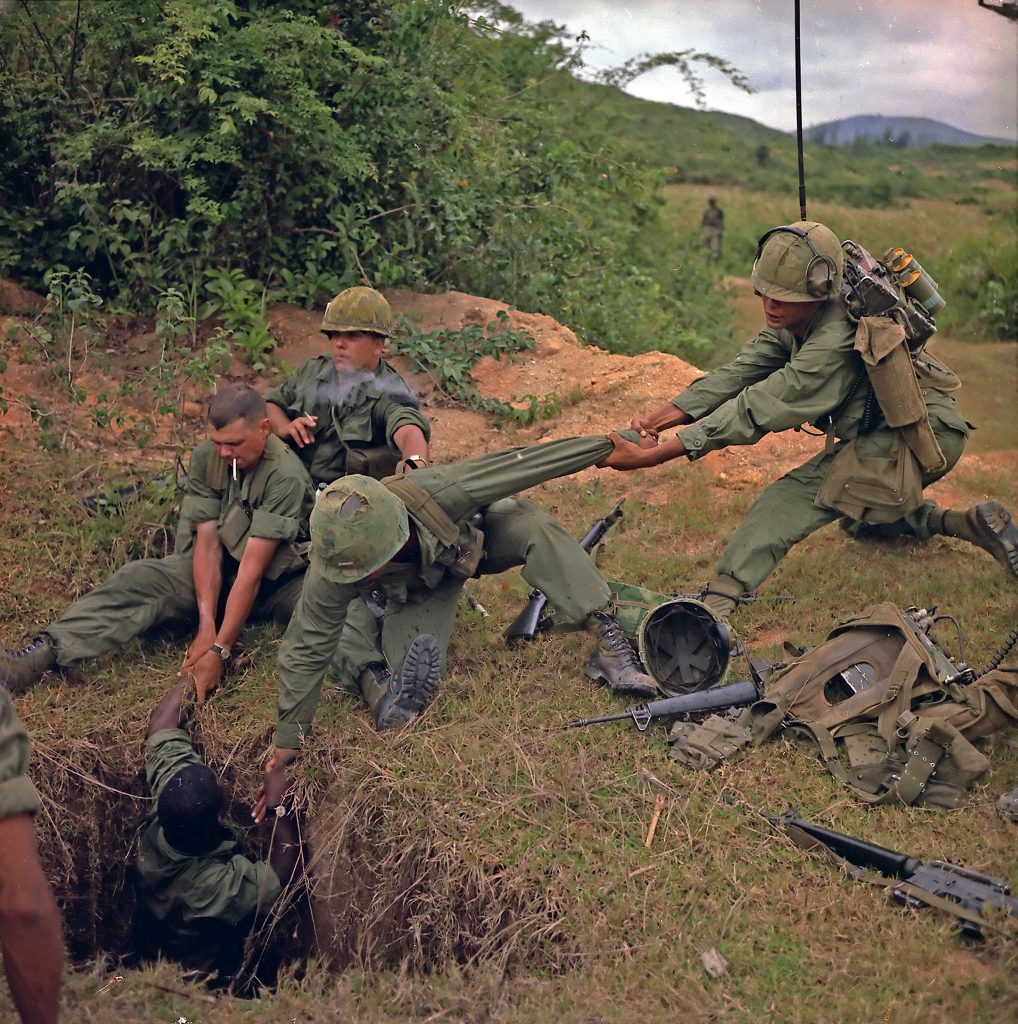If you ever see a flashlight coming your way, you can fire away, but more than likely, you are already a dead man.1
January 7, 1966. The war in Vietnam was raging and the United States had only just begun sending regular combat units as opposed to advisers the year prior. President Lyndon Baines Johnson was steadily escalating the United States’ involvement in Vietnam in an effort to “combat communism.” Eight thousand men descend on a freshly bombed area, hoping to clean up the remnants of Viet Cong in a search and destroy operation. However, when they approached the bombed area, known as the Ho Bo woods, they found nothing but empty fortifications and some rice, evidence that there were once many more men there. The leaders of the Joint American-Australian force were stumped. Where could the Viet Cong have gone?2

They received their answer when one young American soldier sat down to rest, then began exclaiming that he had been stung or bitten on his nether regions. As he began to search for the offending creature, he discovered that what had “stung” him was a nail, protruding from a wooden hatch. This hatch covered a massive underground complex known as the Cu Chi tunnels, spanning some fourteen miles; and this was only one of many tunnel complexes in South and North Vietnam.3 The presence of these tunnels meant that future search and destroy operations would be failures as well, if the tunnels were not dealt with. These tunnels gave the Viet Cong a way to attack U.S. troops from behind, after they had passed overhead; then they could quickly slip back into their tunnels and seemingly vanish. The tunnels also allowed them to hide during bombing runs and as American tanks and helicopters flew by, effectively hiding them from the brunt of American military might. The tunnels could be destroyed using explosives, but these tunnels housed barracks, ammunition and food depots, hospitals, clinics, armories, and rooms with vital military intelligence. These things were often too deep in the tunnels to be destroyed by a blast at the mouth of the tunnel, as the Viet Cong designed their tunnels so that blasts could only destroy small segments. The tunnels were very well made, with sharp right angles every few meters to baffle the blast of an explosive charge, and they had breathing holes dug by taking rabbits and gophers to the bottom of a tunnel and letting them dig themselves back to the surface. After several attempts using tear gas, Acetylene gas, and explosives to flush out the tunnels failed, a new plan emerged. Someone would have to enter the tunnels.4
And thus, the “tunnel rats” were born. These were men, generally small in stature to better fit the small tunnels designed for the smaller Vietnamese physique, and without fear of tight spaces or total darkness, although these are things many tunnel rats would develop after their time in the underground complexes. Armed with nothing more than a flashlight, which was hardly ever used for fear it would alert Viet Cong to the Tunnel rat’s location, a handgun, and a combat knife, sometimes wearing a battery-powered headset, connected to a long cable to let them relay information back to their comrades waiting at the mouth of the tunnel, these men would be lowered into a tunnel, and begin their search.5 Originally made up of men from the famous “Big Red One” 1st Infantry Division present at the original discovery of the Cu Chi tunnels, “tunnel rats” became an unofficial description for someone who had volunteered for this job. This work was mentally and physically taxing, with many volunteers giving up the duty after a few runs, or in many cases, a close call with a Viet Cong soldier in the dark confines of a cave.6
Part of the reason it was such a loathed experience was due to how dangerous an ordeal exploring the tunnels was. If an American tunnel rat were to run into a Viet Cong soldier, the encounter would devolve into hand to hand combat, as firing one’s pistol was very dangerous in tunnels that were barely shoulder-width.7 Firing the large .45 caliber M1911A1 pistol one was issued would definitely lead to ruptured eardrums. This led many of these men to bring captured Vietnamese-used Russian pistols or guns brought from home that were of a smaller caliber–.22 and .38 caliber revolvers being particularly common–that could be more safely fired in the small confines of the tunnels.8

The dangers did not end there either, as the tunnels were frequently booby-trapped, sometimes even with poisonous or venomous snakes and insects, or they had dangerous pits filled with water or gas designed to keep these things away from their living areas of the tunnels. The tunnels were frequently incredibly hot and humid, cramped, sometimes as small as 2.6 feet tall by 2.5 feet wide, and full of unpleasant stagnant air, prompting many tunnel rats to don gas masks in an attempt to make breathing easier.9 Even exiting a tunnel was not safe, as a tunnel rat could travel some distance while underground, then emerge elsewhere, potentially startling a nearby American soldier, which could lead to him being shot. Many tunnel rats would bring smoke grenades with them to use to alert any nearby troops that a friendly would be emerging from a tunnel.10 Because of these hardships, tunnel rats soon gained a reputation as being very courageous, smart, and incredibly lucky to escape a tunnel without dying, and the tunnel rats themselves began to use the motto “Non gratum anus rotendum” or “not worth a rat’s ass.”11
Even with these difficulties, the majority of tunnel rats were very successful. The tunnel rats of the 1st Infantry Division, the only one with any kind of formal training, was especially successful. Consisting of a number of men formally trained to enter the tunnels, radio operators to communicate with them, a medic and a pair of former Viet Cong who could act as translators, the team, led by Sargent Robert Woods, killed 3 Viet Cong soldiers and captured 153 more in a tunnel in August of 1968, just to name one of their most impressive raids. Outside of the formally trained 1st Infantry Division, the volunteer tunnel rats of other companies were sometimes successful as well, securing vital military intelligence, an enemy hospital, or sometimes stores of weapons; these captures accounted for a large portion of seized Viet Cong weapons.12
The tunnel rats where born out of necessity. The United States military had little experience with non-conventional warfare, and needed to adapt quickly to the guerrilla warfare employed by the Viet Cong. During the Vietnam War, even the Australian armed forces had their own “tunnel rats” whom they called “ferrets,” and with the Soviet war in Afghanistan in the 1980s, many Soviet soldiers faced similar hardships in the tunnels of the Mujahideen. Even today, the United States Marine Corps faces similar issues in fighting the Taliban in the cave-like “Kyareses,” or irrigation tunnels of Afghanistan.13 The tunnel rats of Vietnam were one of the first adaptations that the U.S. military made to prepare itself for a new type of warfare, unlike the conventional wars the U.S. had fought in before. But as the number of US casualties from Vietnam rose, American public opinion shifted from support to dissatisfaction, ultimately leading to the United States pulling out of Vietnam, but not before the United States military had learned valuable lessons about guerrilla warfare.

- James Gillam, “Death dance in the dark: James Gillam’s most terrifying moments in Vietnam came in the pitch-black darkness of an enemy tunnel,” Vietnam, 2011., 52, Academic OneFile, EBSCOhost ↵
- Encyclopedia of the Vietnam War: A Political, Social, and Military History, 2011, s.v. “CRIMP Operation,” by Chris Tomas. ↵
- Encyclopedia of the Vietnam War: A Political, Social, and Military History, 2011, s.v. “CRIMP Operation,” by Chris Tomas. ↵
- Encyclopedia of the Vietnam War: A Political, Social, and Military History, 2011, s.v. “Cu Chi Tunnels,” by Richard D. Starnes; “South Viet Nam: The Tunnel Rats,” Time, March 4, 1966. ↵
- Encyclopedia of the Vietnam War: A Political, Social, and Military History, 2011, s.v. “Tunnel Rats,” by James T. Gillam. ↵
- Encyclopedia of the Vietnam War: A Political, Social, and Military History, 2011, s.v. “Tunnel Rats,” by James T. Gillam. ↵
- “I’m not alone down here!” Vietnam, September/October 2015, 42. ↵
- “South Viet Nam: The Tunnel Rats.” Time, March 4, 1966. ↵
- Encyclopedia of the Vietnam War: A Political, Social, and Military History, 2011, s.v. “Tunnels,” by Scott R. Demarco. ↵
- “I’m not alone down here!” Vietnam, September/October 2015, 42. ↵
- George C. Herring, “Vietnam Remembered,” The Journal of American History 73, no. 1 (1986): 152-64; Encyclopedia of the Vietnam War: A Political, Social, and Military History, 2011, s.v. “Tunnel Rats,” by James T. Gillam. ↵
- Encyclopedia of the Vietnam War: A Political, Social, and Military History, 2011, s.v. “Tunnel Rats,” by James T. Gillam. ↵
- Timothy Gusinov, “‘Kyareses’: Taliban’s Death Trap or Escape Route?” Military Intelligence Professional Bulletin 28, no. 2 (April 2002): 46. ↵



58 comments
Trenton Boudreaux
This article correctly makes it out that clearing the Vietnamese tunnels was hard work and it shows the side we rarely see in media about the war in Vietnam. Interesting to see that these kinds of tunnel systems would be used by insurgents in the future and not just in Vietnam. Overall this article was very well written and an interesting read.
Kenneth Gilley
I was impressed at how cleverly the Cu Chi tunnels were built: the sharp right angles to minimize the destruction that could be caused by explosives, the depth to prevent damage from bombing, the booby traps to foil invasions. What I found even more impressive is that there was a group of people brave and dedicated enough to infiltrate these terrifying holes. This article was very informative and entertaining.
Noah Wesolowski
The Vietnam war was a mess from the start to the end even though the United States had the superior technology and more men to throw into combat they ultimately had to pull out of the Vietnam war. After reading about the tunnel rats it’s clean that these were some of the bravest men that fought in the war. They had to crawl alone in the dark in enemy territory and if they got captured or lost there would be no rescue.
Cameron Lopez
I remember reading about how the Vietnam was a huge turning point in U.S history. The fact that we got pulled into this and we followed I don’t think we could of avoided being part of this horrible war. American was in an obvious divide, and this article does a great job portraying that and tells what our American soldiers had to endure in Vietnam. For example the tunnels that were used by the Viet Cong was a strategy that was proved effective towards our Americans that left many injured and dead.
Lyzette Flores
I believe the Cu Chi tunnels were a brilliant idea and an advantage to the Vietnamese. They had a great advantage because they could have easily wiped out the United States. However, they rat tunnels came in the picture and they were not leaving without a fight. They knew that by going down and under the tunnels they were risking their lives but they still chose to do so. The tunnels were smart but the rat tunnels were even smarter.
Mariah Cavanaugh
Your article on tunnel rats was well written. I particularly liked the images that you chose to accompany the article. The photo of Sgt. Ronald A. Payne crawling through the tunnel gave me chills and I could feel myself starting to hyperventilate. I cannot imagine the strength and courage it took to blindly go into a dark and very small tunnel.
Lorenzo Rivera
The Vietnam conflict was a turning point in our Nations history. There was a clear divide in America, however, this article really shows just what our American soldiers had to endure in the jungles of Vietnam. These horrific tunnels used by the Viet Cong were a prime example of guerilla warfare, and proved effective against the Americans. The fact that explosions could potentially destroy certain parts of the tunnels showed just how smart the enemy actually was, and how American soldiers had to come up with measures to combat this tactic.
Daniel Linstead
Thi article did an amazing job of describing the bravery that the tunnel rats had to endure on their duty. It described it in a way I was able to picture them in the tunnel, able to picture the things they would have encounter. It sent shivers down my spine. Pure bravery, and it would take a enormous toll on them both mentally and physically. I enjoyed this article to read.
Esperanza Mauricio
I have always been fascinated by this topic because of how simple but complex the systems were. How they were made is amazing and the traps that were inside some were fairly easy to make and set up. It was a gamble when a soldier was sent into the tunnel because the tunnel could be empty or have enemies or traps. It was a risky job and one most soldiers didn’t want.
Jonathan Perez
Honestly this article did an excellent job of describing the bravery of the US troops in Vietnam. While I knew that Viet Cong used tunnels to hide from US forces, I was unaware that there was a trained group of men that were assigned to the tunnels. The article also did a good job of describing the tunnels and combat situations that occurred in them. Overall this article seemed well researched and was well written.